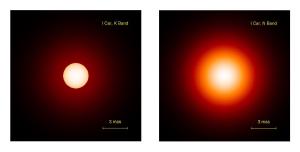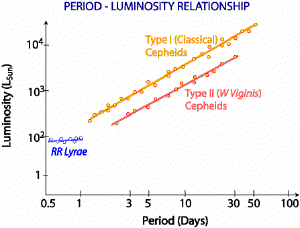Post
Standard Variables
24 June 2013
 ESO, VINCI, MIDI/VLTI
ESO, VINCI, MIDI/VLTIIn the late 1800s Henrietta Leavitt was hired by Edward Pickering of the Harvard College Observatory. “Hired” in this case being a loose term, since Leavitt was not initially paid for her work. She was assigned the task of cataloging the brightness of variable stars from photographic plates. This is a tedious process, which is why it was done by women (known as Pickering’s Harem).
 ATNF
ATNFAs Leavitt cataloged thousands of variable stars in the Magellanic clouds, she noticed a particular trend in a type of variable known as a Cepheid variable, specifically that the rate at which the star varied (its period) correlated with the apparent brightness of the star. By assuming the stars in a particular Magellanic cloud were all essentially the same distance, she was able to demonstrate a linear relationship between absolute brightness (luminosity) and period, seen in the figure. She published her results in 1912.
A year later Enjar Hertzsprung measured the distance of several Cepheid variables in our a galaxy, and confirmed Leavitt’s period-luminosity relation. This meant Cepheids could be used as “standard candles”. By observing their variable period, one could determine their absolute brightness. Comparing this to their apparent brightness, one can determine their distance. This allowed Edwin Hubble to use observations of Cepheids in the Andromeda galaxy to confirm that it was not simply a nebula, but a galaxy millions of light years away. This confirmed that the Milky Way was also a galaxy, and revolutionized our view of the universe.
Today we know of two main types of Cepheids, defined by their metallicity (which we can determine from their spectra). There is also another type of variable known as RR Lyrae, which are smaller and have shorter periods. Their use as standard candles is critical to our determination of the scale of the universe.
All through the standard behavior of certain variable stars.